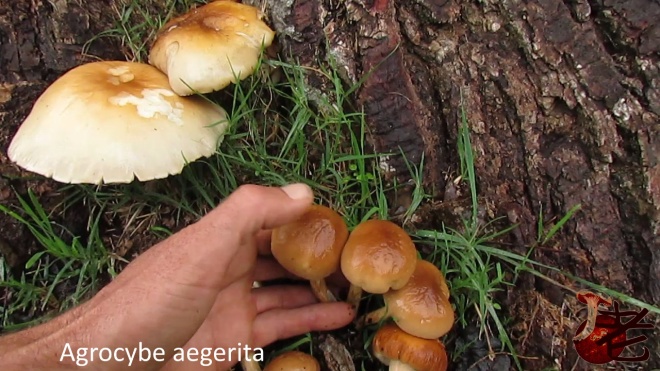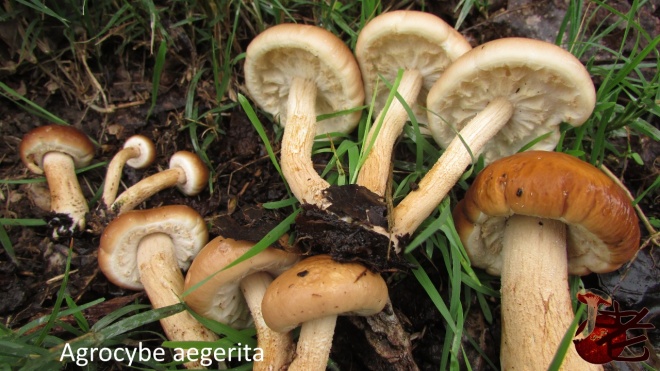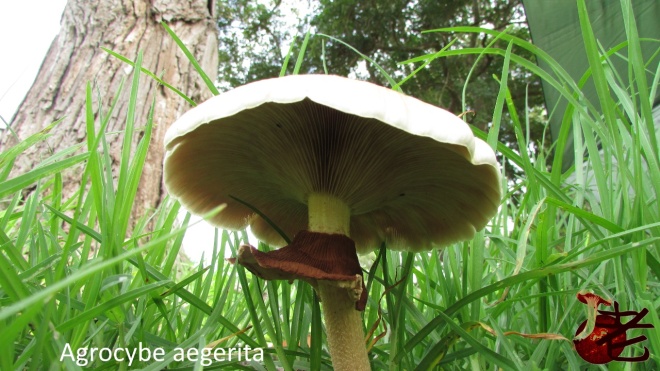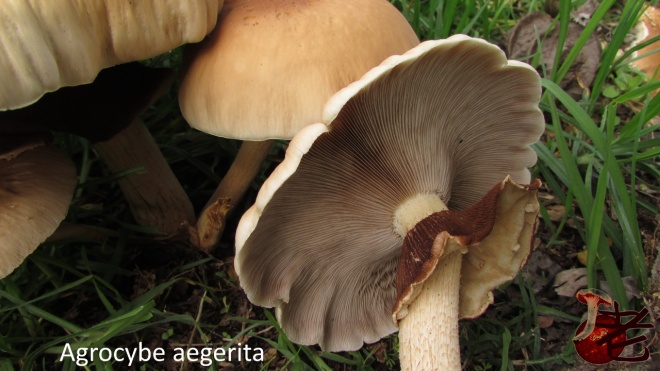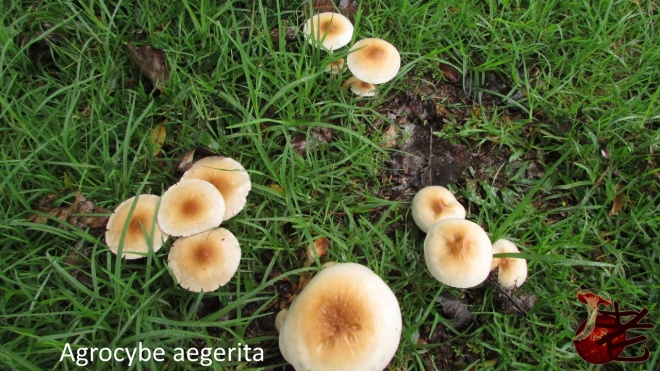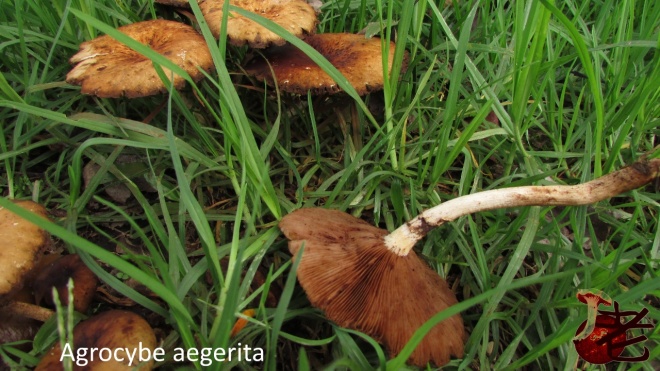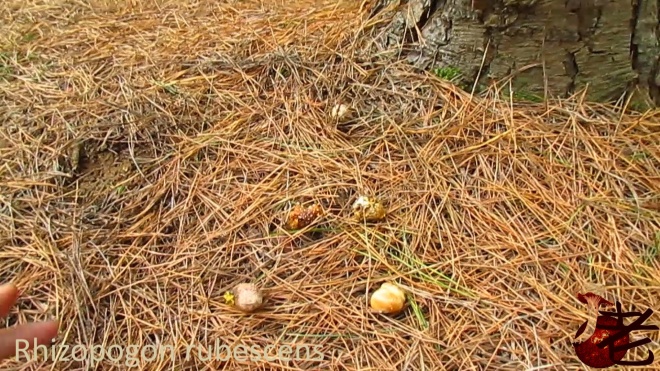I always remember visiting my Uncle George on a sheep property when I was a boy and the introduction to dinner plate size Agaricus with freshly caught trout. Looking back it seemed my mother and grandmother’s generation new enough about wild mushrooms and had the confidence to put them on the table. I rediscovered this kind of culture on a recent trip to Tasmania. Even the elderly folk were out combing the fields.

Collecting field mushrooms Tasmania
Agaricus are quite common, packed with flavour good texture and at times more than you can eat. Part of the genus is not edible, causing stomach upsets and known as Xanthodermus Group. Typically bruising crome yellow when the stem base is rubbed/crushed and stinking of phenol (a disinfectant like smell) , The common name is yellow stainers but that name is confusing because many good eating Agaricus bruise yellow or gold. There are three other distinct smells, mushroomy as in the shop mushroom Agaricus bisporus, sweet almond as Agaricus arvensis, Marzipan as in Agaricus subrufscens group. Some Agaricus bruise red on cutting and are known as Bleeders- like Agaricus bernardii. The smells are heightened when heated.
Agaricus of the Sunshine Coast
The below picture is an Agaricus of medium size, the stem base does not bruise when rubbed and is often buried deep. The stem oxidises orange-gold when cut and rubbed. The stem is notably frilly. The Gills are pink before veil burst turning chocolate brown. The cap gets a golden hue when sun exposed. Growing under Casuarina.

Agaricus Sunshine Coast
Below is a Forest Agaricus occurring close to the beach. The fragrance is sweet almond. The fibrils are concentrated in the centre and golden brown in colour. Smaller up to 10cm diameter.

Agaricus Sunshine Coast
Agaricus arvensis (below) is well known being one of the few edible Agaricus species that turns up in Australian literature. having a golden hue, smelling of sweet almond and tasting delicious. Video Link

Agaricus arvensis Sunshine Coast
Agaricus campestris Video Link

Agaricus campestris Sunshine Coast
Agaricus of the Northern Tablelands
The picture below shows an Agaricus that grows under Pine. The cap is covered in brown fibrils, the gills pale before veil break. Superior ring. Some ribbing around the stem butt. No discolouring. They have a very firm and meaty texture packed with flavour, a favourite from the Northern Tablelands.

Agaricus species of pine- Northern Tablelands
Below– This Agaricus looks similar to A. subrufescens but differs in having a frilly stem and does not have the marzipan flavour. The stem has a thin hollow. Tastes great with firm texture. Found at 760m elevation growing in grass with introduced trees- Monterey Cypress, Monterey pine. . Agaricus perobscurus is a possible match though they are isolated to the San Francisco Bay Area where they are found with the same tree species and interestingly includes Eucalypts.


Below– Agaricus from Armidale, growing close to a large sawdust horse dung pile. Looking like Subrufescens but with a darker cap colouring, pale gills before veil-break becoming red-pink then chocolate. The stem a little frilly. Not much of a bulb and bruising golden at the base. Great flavour meaty texture, non-marzipan.

Agaricus- Armidale

Agaricus- Armidale
Below– another Agaricus from Armidale- growing in grassy area of an Aboreteum. Again similar to Subrufescens but dense and well kept. Cap is dome shaped at first, light coloured with maroon fibrils. Veil has cog-wheeling and gill imprinting on the top side, gills pale-pink before veil breaks then grey becoming chocolate. Stem is bulbous and has a secondary ring like A. bitorquis. There is no bruising. Smells mushroomy- taste more pronounced when mature much like a shop mushroom.

Agaricus sp. Armidale

Agaricus sp. Armidale

Agaricus sp. Armidale
Agaricus in Tasmania
Below two pictures are Agaricus aff crocidilensis growing along the coastal areas. Large meaty and flavoursome. The initial smell is pungent but when the cap margin is rubbed it turns golden and releases a sweet almond smell.

Agaricus aff crocidilensis

Agaricus aff crocidilensis Coastal Tasmania

Agaricus campestris Tasmania
Below is an Agaricus with distinct brown patterns covering the cap, the gills are pink before the veil breaks, these are the brown form of the cultivated Agaricus bisporus. Common around sports fields and parks.

Agaricus bisporus- Field Tasmania
Bellow two pictures are Larger Agaricus of Tasmania. Texture firm, flavour mushroomy. There is some evidence of fibrils in the cap centre. No bruising or colour changes. The gills are pale when young becoming chocolate brown.

Agaricus Tasmania

Agaricus Tasmania
Below is a Forest Agaricus with frilly stem, gills pale when young. I have not eaten this species and include it here out of interest.

Agaricus Forest Tasmania
Below is a larger Agaricus growing in lawn clippings on the drip line of an unknown Conifer. The cap margin when rubbed smells of sweet almond. The gills are pale before veil burst then grey into chocolate brown. The cap fibrils are more of a maroon-pinkish colour. In a field guide to Tasmanian fungi this species possibly matches Agaricus marzipan.

Agaricus Lawn clippings Tasmania
Agaricus austrovinaceus (below) An Australian species Austro and vinaceus in reference to the wine red colour. This species is found generally in Forest or Forest edges.

Agaricus austrovinaceus Forest Tasmania
The below two pictures are forest Agaricus that turn golden with handling, the smell is sweet almond. Reminds me of James Bond Gold finger for some reason.

Agaricus Forest Tasmania
Or a magic lantern that turn golden.

Agaricus Forest Tasmania
In 2020 a group of us were heading to Tasmania but of course the flights were cancelled and the borders closed. Martin Martini had an earlier flight and made it in and was greeted at the Airport by large rings of Agaricus.

Martin Martini greeted by Agaricus rings 2020
These Agaricus were what is known as Bleeders, a section of the group that stain red via bruising or when cut. The other stand out feature was they mature under the ground then surface. I think they are a good match for Agaricus bernardii- the salt loving Agaricus which has been recorded from Corringle Beach in Victoria. They are similar to Agaricus bitorquis but do not have the double ring.

Agaricus bernadii- Luunceston, Tasmania- Martin Martini
The habitat for Agaricus bernardii is coastal grass areas, they like the salt and can also be found in sand dunes.

Agaricus bernadii- showing reddish oxidation- Martin Martini
Though my flight to Tas was cancelled I still felt like I was in Tas thanks to Martin keeping me up to date with his finds.
Agaricus of Sydney

Agaricus Pine Forest Blue Mountains

Agaricus Pine Forest Blue Mountains

Agaricus Pine Forest
The below two pictures are of an Agaricus that smells strongly of Marzipan when the stem base is rubbed. The flavour is intensely Marzipan. Recent DNA work by Kingfisher Mushrooms confirms these mushrooms as Agaricus subrufescens Video Link
They have a history of cultivation but due to to the short shelf life they were discontinued. Then they were popularised in Brazil under the name Agaricus blazei and promoted as a Health product in a dried form. 20 years ago I would collect bucket loads of these on the Autumn equinox from Northey St Community gardens in Brisbane where they flourished in the garden beds and around woodchip piles.
I have created spawn from the spore and successfully introduced them to my market garden. They have always been a favourite of mine and my friends and have great potential to be added into Australian cuisine.

Agaricus subrufscens grp

Agaricus subrufscens grp
The below two pictures are an Agaricus which bruises gold and smells of sweet almond. Video Link

Agaricus arrillagarum Field Coastal Sydney

Agaricus arrillagarum Field Coastal Sydney
Southern Highlands Sydney– (below) a mushroom with the characteristics of Agaricus arvensis but differing in size and stature from the Queensland species.

Agaricus arvensis grp
Agaricus of Sydney growing under Casuarina Sydney- (below) this species is similar to a new species found in South America which is temporarily placed in the subrufescens group. Subrufescens- becoming reddish. Video Link

Agaricus subrufscens grp

Agaricus subrufescens grp
The below two pictures are an Agaricus species found under Casuarina with a stem that bruises yellow then orange then red. The caps flesh bruises reddish on cutting. The stem is smooth above and below the ring. Cap with brown fibrils concentrated in the centre and radiating out on maturity.

Agaricus Casuarina Redening

The below three pictures are an Agaricus found around Casuarina trees in parks and Sports fields of Sydney. The caps fibrils have a maroon tinge. The stem is smooth and hollow when mature, the cell wall is tough when mature. The stem base does not bruise or smell significantly. Internally there is no colour oxidations on cutting. There can be a golden hue in later maturity.

Agaricus Casuarina Sydney

Agaricus Casuarina Sydney

Agaricus Casuarina Sydney
Below three pictures are characteristic of Agaricus bitorquis growing under Casuarina, maturing partly submerged. The gills are reddish-pink before veil burst. The name bitorquis means double collared. The veil is sheathing.

Agaricus Casuarina Sydney

Agaricus Casuarina Sydney

Agaricus Casuarina Sydney
The below Agaricus species was found in the Southern Highlands. They appeared to be submerged growing in a park with mixed trees. The texture was good and nice flavour.

Agaricus Southern Highlands Sydney
Agaricus of Western Australia
Agaricus of Victoria














